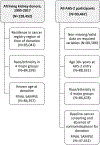Cancer risk in living kidney donors
- PMID: 35510728
- PMCID: PMC9357116
- DOI: 10.1111/ajt.17082
Cancer risk in living kidney donors
Abstract
Living kidney donors are screened for transmissible diseases including cancer. Outcomes following donation are excellent, but concern exists regarding development of chronic kidney disease, and cancer risk is unknown. We used linked transplant and cancer registry data to identify incident cancers among 84,357 kidney donors in the United States (1995-2017). We compared risk with the general population using standardized incidence ratios (SIRs). For selected cancers, we used Poisson regression to compare donors with 47,451 Adventist Health Study 2 (AHS-2) participants, who typically have healthy lifestyles. During follow-up, 2843 cancers were diagnosed in donors, representing an overall deficit (SIR 0.79, 95%CI 0.76-0.82). None of 46 specified cancer sites occurred in excess relative to the general population, and 15 showed significant deficits (SIR < 1.00). Compared with AHS-2 participants, donors had similar incidence of liver cancer, melanoma, breast cancer, and non-Hodgkin lymphoma but, starting 7 years after donation, elevated incidence of colorectal cancer (adjusted incidence rate ratio 2.07, 95%CI 1.54-2.79) and kidney cancer (2.97, 1.58-5.58, accounting for the presence of a single kidney in donors). Elevated kidney cancer incidence may reflect adverse processes in donors' remaining kidney. Nonetheless, cancer risk is lower than in the general population, suggesting that enhanced screening is unnecessary.
Keywords: cancer screening; chronic kidney disease; colorectal cancer; kidney cancer; kidney donation; kidney transplantation.
© 2022 The American Society of Transplantation and the American Society of Transplant Surgeons. This article has been contributed to by U.S. Government employees and their work is in the public domain in the USA.
Figures
Comment in
-
Clear data, careful counseling: Discussing cancer risk after living kidney donation.Am J Transplant. 2022 Aug;22(8):1941-1942. doi: 10.1111/ajt.17106. Epub 2022 Jun 9. Am J Transplant. 2022. PMID: 35620938 No abstract available.
-
Renal Transplantation and Renovascular Hypertension.J Urol. 2023 Mar;209(3):622-623. doi: 10.1097/JU.0000000000003106. Epub 2022 Dec 15. J Urol. 2023. PMID: 36519367 No abstract available.
References
-
- Lentine KL, Kasiske BL, Levey AS, Adams PL, Alberú J, Bakr MA, Gallon L, Garvey CA, Guleria S, Li PK, Segev DL, Taler SJ, Tanabe K, Wright L, Zeier MG, Cheung M, Garg AX. KDIGO Clinical Practice Guideline on the Evaluation and Care of Living Kidney Donors. Transplantation. 2017;101(8S Suppl 1):S1–s109. Epub 2017/07/26. doi: 10.1097/tp.0000000000001769. - DOI - PMC - PubMed
-
actual or reasonably perceived conflicts of interest that may arise from an outside relationship or a personal, professional, or business interest of a member of the work group. All members of the work group are required to complete, sign, and submit a disclosure and attestation form showing all such relationships that might be perceived as or are actual conflicts of interest. This document is updated annually and information is adjusted accordingly. All reported information is published in its entirety at the end of the document and is kept on file at KDIGO.
Publication types
MeSH terms
Grants and funding
- HHSN261201000037C/CA/NCI NIH HHS/United States
- P30 ES005605/ES/NIEHS NIH HHS/United States
- U58 DP003875/DP/NCCDPHP CDC HHS/United States
- HHSN261201000036C/CA/NCI NIH HHS/United States
- U58 DP000807/DP/NCCDPHP CDC HHS/United States
- N01 PC035142/CA/NCI NIH HHS/United States
- HHSN261201000035I/CA/NCI NIH HHS/United States
- U58 DP000848/DP/NCCDPHP CDC HHS/United States
- 75N92021D00009/HL/NHLBI NIH HHS/United States
- HHSN261201800002B/CA/NCI NIH HHS/United States
- U58 DP003883/DP/NCCDPHP CDC HHS/United States
- N01 PC035143/CA/NCI NIH HHS/United States
- HHSN261201800016C/CA/NCI NIH HHS/United States
- N01 PC035139/CA/NCI NIH HHS/United States
- 75N99021D00009/OF/ORFDO NIH HHS/United States
- ZIA CP010150/ImNIH/Intramural NIH HHS/United States
- N01 PC035137/CA/NCI NIH HHS/United States
- HHSN261201800016I/CA/NCI NIH HHS/United States
- U58 DP003933/DP/NCCDPHP CDC HHS/United States
- 75N90021D00009/CL/CLC NIH HHS/United States
- HHSN261201000035C/PC/NCI NIH HHS/United States
- HHSN261201000034C/CA/NCI NIH HHS/United States
- U58 DP003921/DP/NCCDPHP CDC HHS/United States
- 75N96021D00009/ES/NIEHS NIH HHS/United States
- HHSN261201800002C/CA/NCI NIH HHS/United States
- HHSN261201800006I/CA/NCI NIH HHS/United States
- U58 DP000824/DP/NCCDPHP CDC HHS/United States
LinkOut - more resources
Full Text Sources
Medical


